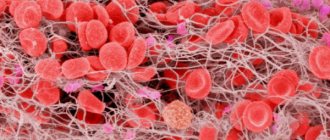Hypoglycemia is a decrease in blood glucose. Let's take a closer look at how hypoglycemia manifests itself in dogs of small and large breeds, the symptoms and treatment of the disease. The norm is blood sugar levels such as 3.5-7.5 mmol/l. If they drop below 3 mol/l, this is an alarming sign. Action needs to be taken.
The pathology poses a danger to pets. Their bodies and brains need sugar. If there is not enough glucose in the blood, there can be dire consequences. This is a hypoglycemic coma, seizures and death. To quickly stop the disease, the veterinarian administers a glucose solution.
What is hypoglycemia?
Hypoglycemia is a decrease in blood sugar. Often the pathology occurs due to diabetes or due to an overdose of insulin. Glucose is a very important source of quick energy, so its sharp decrease causes negative consequences. For example, loss of consciousness. The disease has other causes.
In many dogs, especially older dogs, the disease is not primary. Usually she talks about serious pathological processes in the body.
The danger of hypoglycemia is that the brain needs a constant flow of sugar, because the cells of the nervous tissue do not produce or store it. If a pet's illness continues for a long time, it is very dangerous for the central nervous system. Therefore, it is necessary to take him to the doctor and not try to get rid of the disease on your own. Hypoglycemia is especially harmful in dogs of small breeds, such as Spitz, because they have a very fast metabolism and a lack of glucose is catastrophic.
Treatment method and prognosis
The principle of treating diabetes mellitus is to stabilize the general condition, eliminate symptoms and, most importantly, bring glucose to normal levels (no more than 8-10 mmol/l).
Normalization of glycemic metabolism is carried out with the help of insulin injections, as well as the management of primary and secondary pathologies. It is impossible to completely cure diabetes, so you will have to monitor your blood sugar levels and prevent them from rising in the blood throughout the life of your pet.
Important: for type 1 diabetes mellitus, so-called short-acting insulin is used, for type 2 diabetes, long- or medium-acting insulin is used. When insulin is administered, glucose is brought to a level above the upper normal limit. This measure is due to a reduction in the risk of hypoglycemia - a sharp drop in sugar.
The drug is administered using special injection pens or insulin syringes. The dosage of the medicine is prescribed by the veterinarian based on the condition of the dog. At first it is minimal (0.5 units/kg body weight), then it can gradually increase. To select the dosage, the doctor will need to observe the dog’s condition for several days, and sometimes even months.
Convenient places for insulin administration are the abdomen, chest, and withers. Use your fingers to form a fold of skin, after which a needle is carefully inserted into its base.
The specialist monitors the dynamics of changes in glucose levels, usually using blood tests (every 2-4 hours) as the most convenient method. The veterinarian also evaluates the dog’s general health and behavior: frequency of urination, weight gain, increased appetite. If the dosage of insulin is selected correctly, then the main signs of diabetes disappear.
It is very important to remember that too much insulin is just as dangerous for a dog as too little. So, if the owner does not remember whether he administered the drug or not, it is better not to risk it and skip one injection. Otherwise, the dog may develop Somogyi syndrome, which poses a danger to the patient’s life.
If the doctor's instructions are strictly followed and insulin is administered strictly according to the schedule, you can expect that the dog will live a long and full life. However, from the moment diabetes is diagnosed, the veterinarian becomes a constant consultant and observer of the animal’s well-being.
For what reasons can a pet develop this disease?
To choose a treatment method for a disease, it is important to understand its cause. They may be as follows:
- Juvenile hypoglycemia. Usually seen in puppies younger than 3-4 months. Their body is not fully developed, so it cannot effectively regulate blood sugar levels. At the same time, the need for it has increased. Pathology appears due to worms, stress, malnutrition, diarrhea, vomiting, hypothermia.
- Poor nutrition. The problem also affects adult dogs. Often the cause is hunger. This often occurs in stray dogs and those pets whose owners feed them incorrectly. For example, they give you cheap food or vegetable soup without meat. Other health problems may develop from such a diet.
- Excessive physical activity. Intense training, which is often performed on hunting and working dogs, leads to hypoglycemia. It is necessary to reduce their intensity and not overload the pet in the future.
- Addison's disease. It develops chronic insufficiency of the adrenal cortex. As a result, blood glucose decreases. This is an endocrine pathology. Sometimes it appears due to the use of glucocorticoid drugs. Typically affects animals between three months and 12 years of age. At first, there is a slight deterioration in the condition, but the pathology cannot be started, as this is a risk to life. If signs such as excessive thirst, sudden weight loss, loss of appetite, diarrhea, vomiting, frequent urination and lethargy are observed, you should contact your veterinarian.
- Errors in choosing the dose of insulin. This affects pets who have diabetes. The veterinarian or the owner himself may choose the wrong dose without first discussing this with the doctor. For this reason, negative consequences arise, even death.
- Disturbances in the absorption processes of substances that enter the stomach with food. The reason lies in the disease, which is important to diagnose in time.
- Insulinomas and other neoplasms. Insulinomas develop in the body of the pancreas. As they grow, they produce excessive amounts of insulin, which ultimately leads to a decrease in blood glucose. Other tumors that produce insulin can also cause pathology.
- Liver diseases. At certain stages they act as the cause of the disease.
- Portosystemic shunt. It is a vessel that usually passes through or bypasses the liver, connecting the systemic venous circulation and the portal vein. In some cases there are two of them.
- Genetic diseases. For example, a pathology due to which glycogen accumulates.
- Sepsis. This is a bacterial infection that causes problems in the body.
Causes
It is impossible to establish the exact factors leading to the development of pathology. Scientists say the main reason is genetic predisposition.
Other factors:
long-term treatment with corticosteroids (hormonal drugs);- overweight animal;
- hormonal disorders;
- previous pancreatitis;
- in bitches 1st month after estrus, pregnancy;
- age over 7 years;
- acute and chronic infectious diseases;
- lack of physical activity.
It is noted that females are 2 times more likely to suffer from diabetes than males.
Symptoms of hypoglycemia in dogs
The signs are influenced by the form of the pathology. Typically the symptoms are as follows:
- excessive salivation;
- weakness, drowsiness, apathy;
- refusal to eat;
- chills;
- digestive disorders;
- decreased activity.
Acute hypoglycemia manifests itself as follows:
- loss of consciousness;
- severe convulsions;
- coma;
- paralysis.
How can the disease be diagnosed?
The specialist first measures your glucose using a glucometer. Blood is drawn and then applied to a strip of the device. The device quickly produces results. After this, diagnostics are carried out to identify the cause of the disease:
- General blood analysis.
- Biochemistry of blood. With its help, you can evaluate the functioning of the internal systems of the body.
- Analysis of urine. Blood leakage and kidney failure are detected.
- Test for Addison's disease.
- Ultrasound examination of the abdominal organs. The presence of oncological pathologies is determined.
- X-ray of the abdomen and chest. Allows you to see neoplasms that cause hypoglycemia.
- Test for insulin levels in a certain amount of blood sugar. Thus, insulinoma is diagnosed.
How to treat a sick pet?
For treatment, it is necessary to diagnose the cause of hypoglycemia, then a method is selected based on it. It is important to eliminate the acute form immediately.
An attack of hypoglycemia looks quite scary, so many inexperienced owners do not know what to do to stop it. To provide first aid, an injection with a glucose solution is given. You can also rub it into your gums.
In mild cases, sweet water with sugar or honey, or sweets are used. If he refuses such a drink, he will need to open his mouth and forcefully pour it in. It is important to act carefully to prevent your pet from choking. To make the procedure easier, you should find a person who will hold it. If the dog is unconscious, it is not worth carrying out. Otherwise, aspiration into the respiratory organs will occur.
This will stabilize the pet's condition. Often with pathology, body temperature decreases, so you need to wrap the dog in a blanket and use heating pads with water. Carboxylase and vitamin B are used to normalize heart function.
Physical activity is suspended. Walks should be short, their main purpose is to relieve natural needs. Your doctor may recommend giving Creon or Mezim with food.
If the condition is severe, the pet is treated in a hospital so that urgent measures can be taken if it worsens. If the disease is caused by malignant neoplasms, glucocorticosteroids are prescribed. The treatment regimen is chosen by a specialist. Chemotherapy and surgery may also be required.
Forecasts
The prognosis also depends on the cause of the disease:
- Juvenile hypoglycemia. It is favorable if the owner takes the dog to the veterinary clinic in a timely manner.
- Starvation. The disease will disappear if you provide your pet with a proper and nutritious diet.
- Excessive physical activity. It is not dangerous, since it is possible to normalize blood glucose levels by reducing activity and taking medications.
- Insulinoma. This is a malignant tumor, so the prognosis is poor. Especially if metastases have already formed.
- Liver diseases, sepsis, impaired intestinal absorption, genetic pathologies, portosystemic shunts. In these cases, the prognosis is influenced by the timeliness of treatment, its relevance and the severity of the disease.
Video: hypoglycemia in dogs of small and large breeds, its symptoms and treatment
Prevention methods
Since it is still not entirely clear what provokes a malfunction of the pancreas, which subsequently leads to diabetes mellitus, a healthy lifestyle should be considered one of the primary preventive measures.
A dog's healthy lifestyle is not much different from a human's - it consists of a well-regulated daily routine, physical activity, walks in the open air, balanced nutrition, hardening and the absence of infectious diseases.
But even if these rules are followed, it is impossible to exclude the disease, which is often inherited. If your pet does get sick, diabetes cannot be ignored: the longer the pathology develops, the more difficult it is to start treatment.
This is interesting! In advanced forms of the disease, ketone bodies accumulate in the blood. Ketoacidosis delays insulin therapy, which is started only after the removal of ketone bodies (otherwise there will be no result).
If the diagnosis is not made on time, the dog faces:
- cataracts with subsequent loss of vision;
- heart/renal failure;
- fatty liver (often to cirrhosis);
- physical impotence;
- extreme exhaustion;
- fatal.
An owner who follows the advice of an endocrinologist (who is responsible for the insulin correction regimen and an approximate diabetic menu) will ensure his dog a long and fulfilling life.











